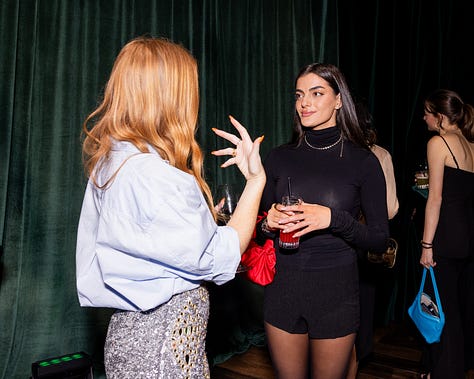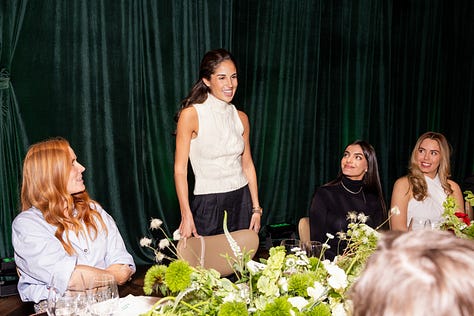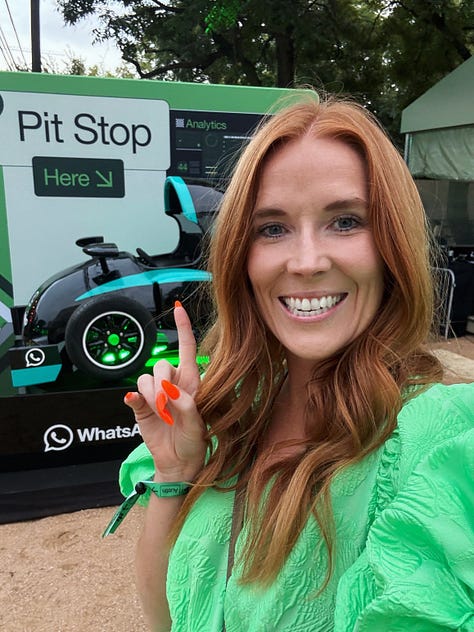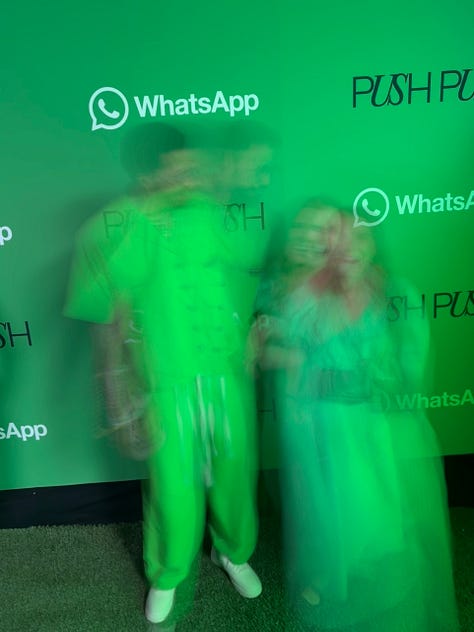The Group Chat Runs the Grid
More Than a Message App: How WhatsApp Made Itself Indispensable in the Paddock
Thank you for being here. You are receiving this email because you subscribed to Idée Fixe, the newsletter for curious minds. I’m Toni Cowan-Brown, a tech and F1 commentator. I’ve spent the past five years on the floor of way too many F1, FE, and WEC team garages, learning about the business, politics, and tech of motorsports. I hope you’ll stick around.
⏳ Reading time: 8 minutes
How WhatsApp Became F1’s Most Organic Sponsor
As I was watching the Saudi Arabian Grand Prix on Sunday, I caught some of the pre-race show and laughed when I heard Ollie Bearman (Haas F1 Team driver) say the following in response to Laura Winter asking him - What’s it like in that moment to hear those different voices pop in on the radio to say well done? “It was cool. It felt like I was on a WhatsApp group call with my family, I was waiting for my mum, and my sister and my dog [to join the call].”
When brands enter Formula 1, they usually go big. Think car liveries, hospitality suites, grid walks, or they get creative and activate on the periphery of the sport. But some of the smartest sponsorships aren’t the loudest - they're the ones that just make sense.
WhatsApp’s partnership with Mercedes AMG Petronas F1 Team is a masterclass in subtlety and strategy, and I’ve been shouting about it since day one. In a sport that lives on precision, speed, and constant communication across borders, WhatsApp isn’t just a tool - it’s the default mode of operation for many working in and around this sport. It’s how engineers message strategy notes across time zones, how mechanics stay in sync during track build-outs, and yes, how Toto probably texts George and Kimi. There is even a driver group chat, which I believe George Russell is the admin of - or that may just be a rumour. The F1 paddock is a hyper-global workplace, and WhatsApp is its connective tissue.
How the Deal Came to Be
The seeds of the partnership were planted organically, which actually makes sense. The Mercedes F1 team had long used WhatsApp internally, much like every team in the paddock. Meta (WhatsApp’s parent company) saw an opportunity to transform that internal reliance into an outward-facing story.
Sources close to the deal say it started with conversations not about ROI, but about relevance. As a sport vying for cultural relevance, Formula 1 should really be taking notes. Meta had dabbled in sports, but never found a property that married culture, global appeal, and technology the way Formula 1 did. This partnership came at a perfect time - Formula 1 is in the midst of its USA expansion and appeal, and WhatsApp has been on that same trajectory, trying to get more users in America. An expansion that has gained significant momentum recently, according to The Verge, reaching 100 million monthly active users as of July 2024.
The partnership with Mercedes AMG Petronas F1 exemplifies WhatsApp's strategic positioning. By aligning with a globally recognised team that operates across diverse regions and relies heavily on efficient communication, WhatsApp reinforces its brand as an essential tool for seamless, secure messaging. This collaboration not only enhances brand visibility but also underscores WhatsApp's commitment to facilitating real-time, cross-border communication.
F1's Most Understated Yet Brilliant Brand Partnership
The partnership has since evolved into a platform for storytelling, branding, and subtle product placement. From emoji car stunts to branded steering wheels to cinematic content with Lewis Hamilton, it’s never felt like traditional sponsorship - it feels like participation, which is probably why I loved this partnership so much in the first place. When Meta decided to put its name next to Mercedes, it wasn’t just about brand awareness. It was brand alignment. And the execution has been just as smart. Here are just a few highlights that have stood out to me:
The emoji car: In a genius bit of brand hacking, WhatsApp temporarily replaced the car emoji in their app with a silver Mercedes F1 car—subtle, funny, and wildly viral. Watch my video breakdown on this here - this was the moment all my lightbulbs went off.
The physical emoji car: Mercedes built a real-life version of that emoji and drove it through the paddock, and in the streets of NYC, merging digital culture with physical presence.
WhatsApp x Lewis Hamilton short film: Instead of a traditional ad, they dropped a beautifully shot short about Lewis’s life and leadership, told through his own WhatsApp messages. It was intimate, cinematic, and totally unexpected. I was kindly invited by the WhatsApp team to attend the first screening of this short film in Austin last year.
Product placement without the cringe: The WhatsApp logo now lives on the drivers’ steering wheels, on their headphones, and across team gear.
The result is a sponsorship that feels less like a marketing gimmick and more like a natural part of the sport’s fabric. It’s rare to see a tech brand play the long game in sports with this much subtlety and payoff. But WhatsApp has shown that when you’re already in everyone’s pocket, in their hands at all times - and their group chats - you don’t have to shout about it, a simple nod will do the trick.
But What’s the ROI?
So, what does Meta get in return? Here's the thing: the metrics of modern sponsorship are changing (and I wish more brands took note of this, but those that are are winning big). Old-school brand deals focused on media value and logo impressions. But for a product like WhatsApp, which is free and already has 2 billion users, it’s not purely about awareness. It’s about affinity and cultural positioning.
This deal doesn’t feel like a pure acquisition play, it feels more about reminding existing customers that WhatsApp is more than just a messaging app and growing awareness in America. It’s secure. It’s global. It’s essential. It’s what world champions use to get the job done. It’s what one of the most tech-oriented sports uses.
And the Mercedes F1 team gets to lean into a tool they already rely on, while also unlocking a fresh, global-facing content engine powered by one of the world’s biggest platforms. That short film with Lewis? It wasn’t just an ad - it was character development. It was about putting out content that fans would like and consume. Stay tuned, as I hear there is more great content coming out during the Miami Grand Prix so stay tuned.
It’s no surprise that Meta has leaned into metrics like engagement over impression, storytelling over static assets and long-term brand integration over seasonal activations
The Bigger Picture: Tech’s Second Wave in Formula 1
The WhatsApp deal also marks a subtle shift in F1’s tech sponsorship landscape. For much of the last decade, tech sponsors were almost exclusively B2B:
AWS powers data analysis for F1 and Scuderia Ferrari
Juniper Network supports Aston Martin’s connectivity stack
Salesforce backs McLaren as a digital transformation partner (as well as an F1 partner)
Workday, Oracle, Bitdefender and NetApp are all over the paddock
Unlike many of these tech sponsors that lean heavily into B2B cloud services or AI solutions, WhatsApp is a B2C app that people already have a deep, habitual connection with - especially outside of the United States. The brand didn’t have to force relevance; it already was relevant. They simply shined a spotlight on their presence and usage across the Paddock.
These partnerships also serve internal performance goals and executive-level optics. And they resonate more with C-suite executives than they do with the average fan. Enter the B2C wave. WhatsApp joins tech brands and platforms like:
TikTok (sponsor of the Aston Martin F1 Team)
Snapchat (in 2017, Formula 1 and Snap Inc. announced a global partnership)
YouTube (was once part of creating an F1 team)
Netflix (while not a sponsor, arguably one of F1’s biggest growth engines)
These consumer tech brands understand that Formula 1 isn’t just an engineering sport; it’s a cultural product. The fans aren’t just watching - they’re participating, sharing, memeing, editing, and group chatting. For these brands, F1 is the perfect global stage: high drama, glamorous visuals (just don’t use these visuals or a cease & desist will swiftly land on your doorstep), weekly storylines, and an audience that skews younger, richer, and digitally native.
WhatsApp’s sponsorship of Mercedes is a reminder that sometimes the smartest partnerships don’t shout. They simply just make sense. In an era where fans are increasingly sceptical of corporate logos and jargon-laced “cloud and AI partnerships,” WhatsApp offers something rare: relevance. It’s not just a sticker on a car - it’s the group chat that makes the car go fast.









🔗 F1 makes key 2026 changes and future engine plans | The Race
Formula 1 looks set to adopt a series of rules concessions for 2026 aimed at alleviating concerns about the new engine regulations. The mooted switch to V10s engines was also a key part of a big engine summit on the Friday of the Bahrain Grand Prix, as Edd Straw and Jon Noble explain all you need to know. Watch here.
🔗 The unreality of reality TV: How competition shows influence U.S. politics and shape views about economic inequality | Niemenlab
The book is about the political consequences of people getting tuned out of news, because they suddenly had many more choices than they used to. Read here.
🔗 How society dismisses women’s interests and crowns men’s as culture | The Meraki project
Why is it that the things women love are often the punchline, while the things men enjoy are treated as cultural landmarks? Read here.





